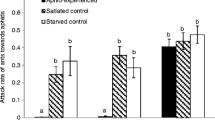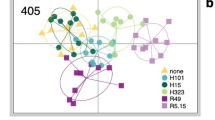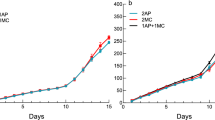Abstract
In mutualisms, partner discrimination is often the most important challenge for interacting organisms. The interaction between ants and aphids is a model system for studying mutualisms; ants are provided with honeydew by aphids and, in turn, the ants offer beneficial services to the aphids. To establish and maintain this system, ants must discriminate mutualistic aphid species correctly. Although recent studies have shown that ants recognize aphids as mutualistic partners based on their cuticular hydrocarbons (CHCs), it was unclear which CHCs are involved in recognition. Here, we tested whether the n-alkane or methylalkane fraction, or both, of aphid CHCs were utilized as partner recognition cues by measuring ant aggressiveness toward these fractions. When workers of Tetramorium tsushimae ants were presented with dummies coated with n-alkanes of their mutualistic aphid Aphis craccivora, ants displayed higher levels of aggression than to dummies treated with total CHCs or methyl alkanes of A. craccivora; responses to dummies treated with n-alkanes of A. craccivora were similar to those to control dummies or dummies treated with the CHCs of the non-mutualistic aphid Acyrthosiphon pisum. By contrast, ants exhibited lower aggression to dummies treated with either total CHCs or the methylalkane fraction of the mutualistic aphid than to control dummies or dummies treated with CHCs of the non-mutualistic aphid. These results suggest that T. tsushimae ants use methylalkanes of the mutualistic aphid’s CHCs to recognize partners, and that these ants do not recognize aphids as partners on the basis of n-alkanes.

Similar content being viewed by others
References
Blomquist GJ, Bagnères AG (2010) Insect hydrocarbons: biology, biochemistry, and chemical ecology. Cambridge University Press, Cambridge
Endo S, Itino T (2012) The aphid-tending ant Lasius fuji exhibits reduced aggression toward aphids marked with ant cuticular hydrocarbons. Popul Ecol 54:405–410
Greene MJ, Gordon DM (2007) Structural complexity of chemical recognition cues affects the perception of group membership in the ants Linepithema humile and Aphaenogaster cockerelli. J Exp Biol 210:897–905
Hayashi M, Nakamuta K, Nomura M (2015) Ants learn aphid species as mutualistic partners: Is the learning behavior species-specific? J Chem Ecol 41:1148–1154
Hojo MK, Yamamoto A, Akino T, Tsuji K, Yamaoka R (2014) Ants use partner specific odors to learn to recognize a mutualistic partner. PLoS One 9:e86054
Lang C, Menzel F (2011) Lasius niger ants discriminate aphids based on their cuticular hydrocarbons. Anim Behav 82:1245–1254
Nelson DR, Blomquist GJ (1995) Insect waxes. Waxes: chemistry, molecular biology and functions. The Oily Press, Dundee
R Development Core Team (2016) R: A Language and environment for statistical computing. R Foundation for Statistical Computing, Vienna, Austria http://www.R-project.org/
Sakata H (1995) Density-dependent predation of the ant Lasius niger (Hymenoptera: Formicidae) on two attended aphids Lachnus tropicalis and Myzocallis kuricola (Homoptera: Aphididae). Res Popul Ecol 37:159–164
Stadler B, Dixon AFG (2005) Ecology and evolution of aphid-ant interactions. Annu Rev Ecol Evol S 36:345–372
Sturgis S, Gordon D (2012) Nestmate recognition in ants (Hymenoptera: Formicidae): a review. Myrmecol News 16:101–110
van Wilgenburg E, Felden A, Choe DH, Sulc R, Luo J, Shea KJ, Elgar MA, Tsutsui ND (2012) Learning and discrimination of cuticular hydrocarbons in a social insect. Biol Lett 8:17–20
Acknowledgments
We thank Jocelyn G. Millar of the University of California, Riverside for reviewing the manuscript, Kazuki Tsuji of the University of the Ryukyus for constructive comments, and Shigeru Matsuyama of the University of Tsukuba and Harunobu Shibao of the University of Tokyo for technical advices. This study was supported by JSPS KAKENHI (Grant No. 17 J04148 to MH and 16 K14865 to KN).
Author information
Authors and Affiliations
Corresponding author
Rights and permissions
About this article
Cite this article
Sakata, I., Hayashi, M. & Nakamuta, K. Tetramorium tsushimae Ants Use Methyl Branched Hydrocarbons of Aphids for Partner Recognition. J Chem Ecol 43, 966–970 (2017). https://doi.org/10.1007/s10886-017-0891-3
Received:
Revised:
Accepted:
Published:
Issue Date:
DOI: https://doi.org/10.1007/s10886-017-0891-3




